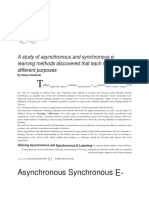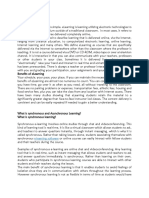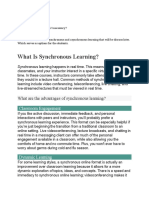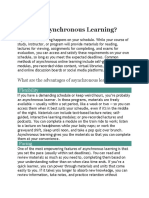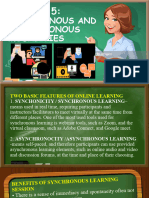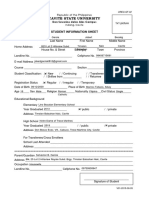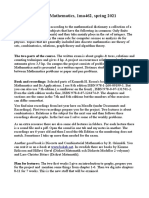0% found this document useful (0 votes)
37 views5 pagesAsynchronous vs Synchronous E-Learning
This document summarizes a study that compared asynchronous and synchronous e-learning methods. The study found:
1) Asynchronous e-learning, which uses tools like email and discussion boards, allows learners to participate at different times and gives more time for thoughtful responses. However, it lacks the immediate feedback of synchronous learning.
2) Synchronous e-learning, using tools like video conferencing and chat, allows for real-time question-answering and interaction, which helps build a sense of community. However, it requires learners to participate at the same time.
3) Both methods have benefits and limitations, so organizations should understand when each is best used based on learner needs and the purpose
Uploaded by
Suman GuchaitCopyright
© © All Rights Reserved
We take content rights seriously. If you suspect this is your content, claim it here.
Available Formats
Download as PDF, TXT or read online on Scribd
0% found this document useful (0 votes)
37 views5 pagesAsynchronous vs Synchronous E-Learning
This document summarizes a study that compared asynchronous and synchronous e-learning methods. The study found:
1) Asynchronous e-learning, which uses tools like email and discussion boards, allows learners to participate at different times and gives more time for thoughtful responses. However, it lacks the immediate feedback of synchronous learning.
2) Synchronous e-learning, using tools like video conferencing and chat, allows for real-time question-answering and interaction, which helps build a sense of community. However, it requires learners to participate at the same time.
3) Both methods have benefits and limitations, so organizations should understand when each is best used based on learner needs and the purpose
Uploaded by
Suman GuchaitCopyright
© © All Rights Reserved
We take content rights seriously. If you suspect this is your content, claim it here.
Available Formats
Download as PDF, TXT or read online on Scribd
/ 5
